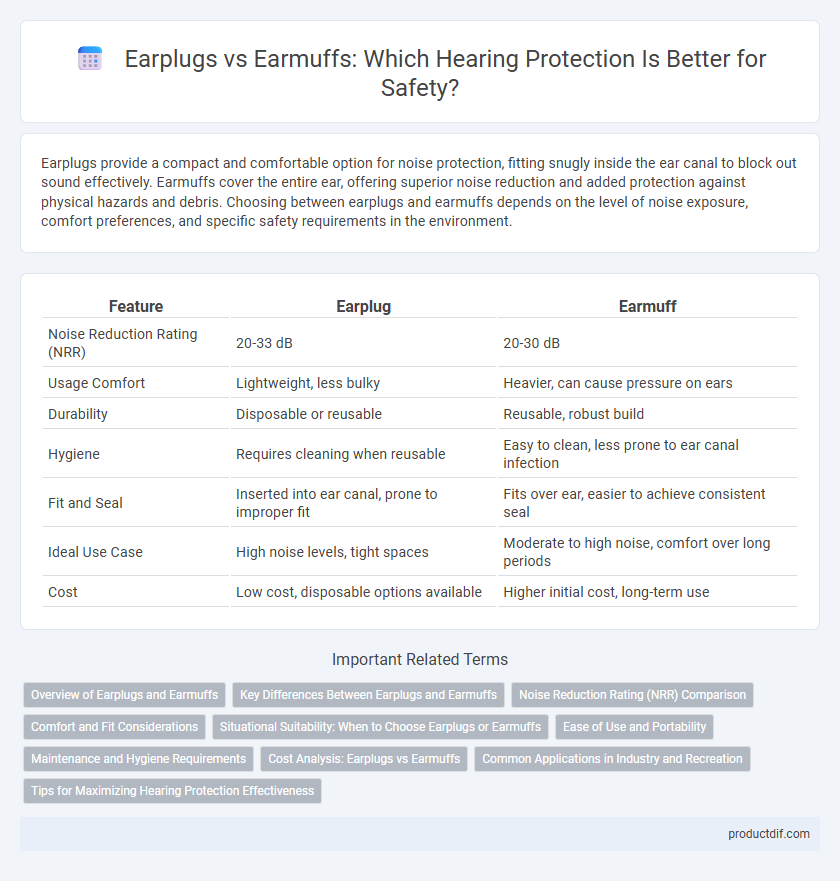Earplugs provide a compact and comfortable option for noise protection, fitting snugly inside the ear canal to block out sound effectively. Earmuffs cover the entire ear, offering superior noise reduction and added protection against physical hazards and debris. Choosing between earplugs and earmuffs depends on the level of noise exposure, comfort preferences, and specific safety requirements in the environment.
Table of Comparison
| Feature | Earplug | Earmuff |
|---|---|---|
| Noise Reduction Rating (NRR) | 20-33 dB | 20-30 dB |
| Usage Comfort | Lightweight, less bulky | Heavier, can cause pressure on ears |
| Durability | Disposable or reusable | Reusable, robust build |
| Hygiene | Requires cleaning when reusable | Easy to clean, less prone to ear canal infection |
| Fit and Seal | Inserted into ear canal, prone to improper fit | Fits over ear, easier to achieve consistent seal |
| Ideal Use Case | High noise levels, tight spaces | Moderate to high noise, comfort over long periods |
| Cost | Low cost, disposable options available | Higher initial cost, long-term use |
Overview of Earplugs and Earmuffs
Earplugs and earmuffs serve as essential safety equipment designed to protect hearing in noisy environments, with earplugs fitting directly into the ear canal to block sound, while earmuffs cover the entire outer ear to provide noise reduction. Earplugs offer a lightweight, portable solution ideal for those needing discreet protection, typically providing noise reduction ratings (NRR) between 20 to 33 decibels. Earmuffs, generally bulkier, are favored in industrial settings for their consistent fit and higher durability, often featuring adjustable headbands and cushioning to enhance comfort during prolonged use.
Key Differences Between Earplugs and Earmuffs
Earplugs are small devices inserted directly into the ear canal, providing a snug fit that blocks out high-frequency noise and are ideal for consistent use in hot environments due to their lightweight design. Earmuffs cover the entire outer ear with cushioned cups, offering better protection against low-frequency sounds and are preferred in colder climates or situations requiring quick removal. The key differences lie in comfort, noise reduction rating (NRR), and usability, with earplugs generally offering higher attenuation but requiring proper insertion for effectiveness, while earmuffs provide easier fit adjustments and are more visible for safety compliance.
Noise Reduction Rating (NRR) Comparison
Earplugs typically offer a Noise Reduction Rating (NRR) between 20 to 33 decibels, providing a more customizable and often higher level of noise attenuation when properly fitted. Earmuffs generally have an NRR ranging from 20 to 30 decibels, with effectiveness varying based on size and seal quality around the ears. Combining earplugs and earmuffs can enhance overall noise reduction, achieving a cumulative NRR above 33 decibels in high-noise environments.
Comfort and Fit Considerations
Earplugs offer a customized fit by conforming to the ear canal, providing lightweight comfort ideal for extended wear, while earmuffs can feel bulkier but offer consistent coverage around the entire ear. Comfort depends on factors such as ear shape, size, and personal sensitivity, where some users may find earmuffs less intrusive but warmer in hot conditions. Proper fit ensures maximum noise reduction; earplugs require correct insertion depth, while earmuffs must form a tight seal without excessive pressure to prevent discomfort.
Situational Suitability: When to Choose Earplugs or Earmuffs
Earplugs offer superior suitability in hot, humid environments or when wearing helmets, as their compact design ensures comfort and compatibility. Earmuffs provide enhanced protection in extremely noisy settings and are preferable when ease of removal is needed for intermittent noise exposure. Choosing based on situational factors like noise level, environmental conditions, and personal comfort optimizes hearing protection effectiveness.
Ease of Use and Portability
Earplugs offer superior portability due to their compact size, making them easy to carry in pockets or small cases. Earmuffs, while bulkier, provide quick on-and-off use without the need for insertion, benefiting users who require frequent removal. Ease of use for earplugs can vary depending on proper fit, whereas earmuffs deliver consistent protection with minimal adjustment.
Maintenance and Hygiene Requirements
Earplugs require regular cleaning or replacement to prevent ear infections and maintain hygiene, with disposable options offering the least maintenance. Earmuffs need routine wiping of cushions and bands with disinfectant to avoid buildup of dirt and sweat, ensuring optimal performance and user comfort. Proper maintenance of both is essential in industrial safety to prolong lifespan and guarantee effective hearing protection.
Cost Analysis: Earplugs vs Earmuffs
Earplugs generally offer a lower initial cost compared to earmuffs, making them a budget-friendly option for individual users and large teams. Earmuffs, while more expensive upfront, provide reusable durability and may reduce long-term replacement expenses, especially in industrial settings. Cost analysis should factor in not only purchase price but also maintenance, lifespan, and comfort-related compliance, as these impact overall safety investment efficiency.
Common Applications in Industry and Recreation
Earplugs and earmuffs are essential safety equipment used across various industries and recreational activities to prevent noise-induced hearing loss. Earplugs are commonly preferred in environments requiring lightweight, discreet protection such as manufacturing, construction, and concerts, while earmuffs provide superior attenuation in high-noise settings like shooting ranges, heavy machinery operation, and aviation. The choice between earplugs and earmuffs often depends on factors like noise levels, comfort, and the need for communication during industrial tasks or outdoor sports.
Tips for Maximizing Hearing Protection Effectiveness
Properly fitting earplugs create a seal that blocks harmful noise levels, while earmuffs must fully cover the ear with a tight seal around the head. Using both earplugs and earmuffs together significantly enhances noise reduction, especially in extremely loud environments such as construction sites or industrial settings. Regularly inspecting equipment for damage and maintaining cleanliness ensures optimal performance and long-term hearing protection.
Earplug vs Earmuff Infographic

 productdif.com
productdif.com